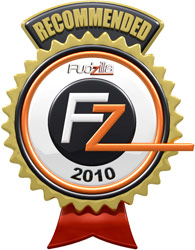Index


Review: Passive solution for Core i7
We've already written about Thermalright's HR-02 CPU cooling, one of the pretty hefty solutions claiming to pack enough punch to passively cool a Core i7. As sceptical as we are, we've had our doubts as well, but Thermalright has proven to be right on the money. In fact, semi-passive operation will help the HR-02 in cooling a Core i7 930 at 2.8GHz and even a Core i7 965 Extreme at 3.2GHz.
HR-02 has a large dissipation surface making it easy for the passive cooler to release heat. Like any other passive cooling solution, HR-02 too requires at least some basic airflow within the case. HR-02 performance will naturally be improved if you strap it with a fan, but since the HR-02 was designed to passively cool Core i7 CPUs at reference voltages and clocks, a decent airflow within the case will do the trick.
Thanks to the design, HR-02’s heatsink is moved towards the spots where case fans are usually placed. Thermalright did a pretty good job with this move as it makes the case and the accompanying fans work in its favor and improves performance in the so called semi-passive operation.
As you can see from the pictures, there are six nickel plated heatpipes (6mm in diameter) branching out both ways from the copper base. The cooler’s base isn’t dead center below the heatsink as on most CPU coolers. The heatsink is somewhat leaning towards the fan on the back panel or, if you turn the cooler by 90 degrees, towards the top fan.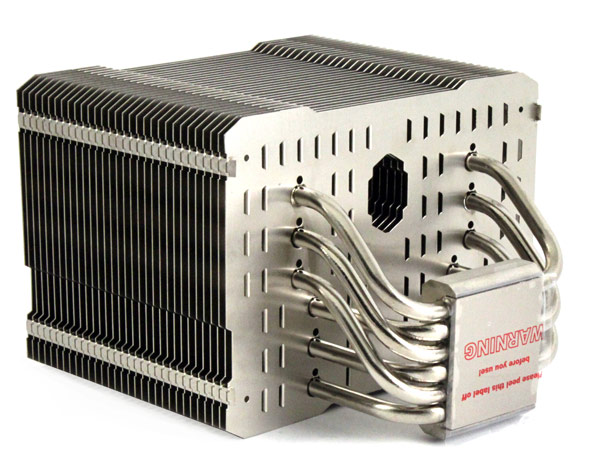
The following picture shows the HR-02 turned towards the back panel fan. We strapped our HR-02 with a TR-TY1-140mm fan so as to get the push-pull effect. If you’re looking to overclock your CPU, adding one or two silent (12cm or 14cm) fans on the HR-02 will get you additional cooling without introducing unwanted noise.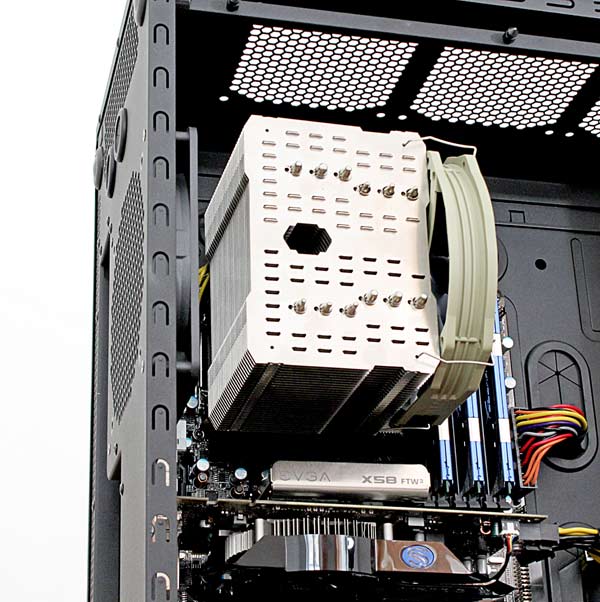
You’ll notice many openings in the heatsink, which helps prevent hot air pockets, improves airflow and speeds up the dissipation process.
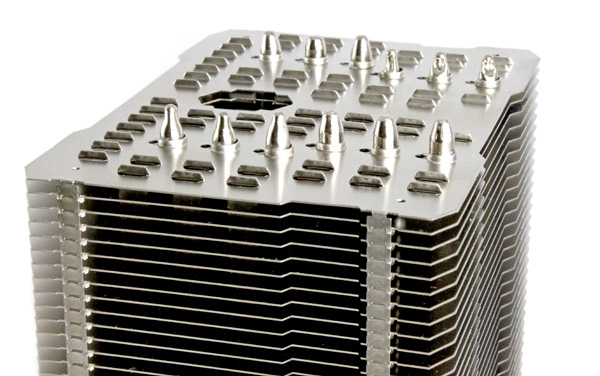
A careful observer will notice a big hole on the top of the heatsink and it stretches all the way to the bottom. The reason is the screw located below the heatsink and Thermalright bundled an appropriate screwdriver – a really nice touch indeed.
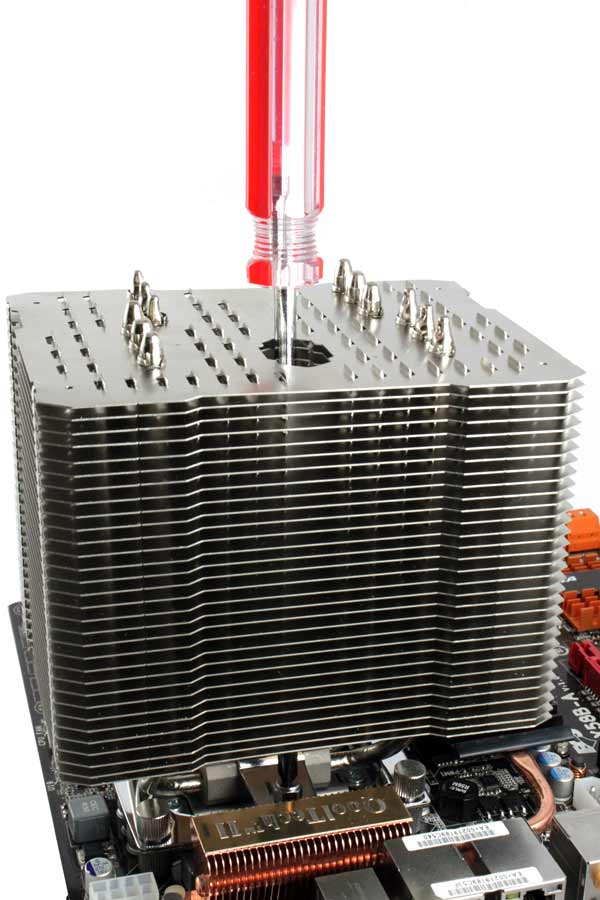
HR-02 measures 110 x 140 x 160 (L x W x H) and weighs in at 860 grams (without the fan and bracket system). The cooler is a giant indeed and to paint a picture of just how big it is, here’s a comparison to a single 2.5 inch SSD disk.
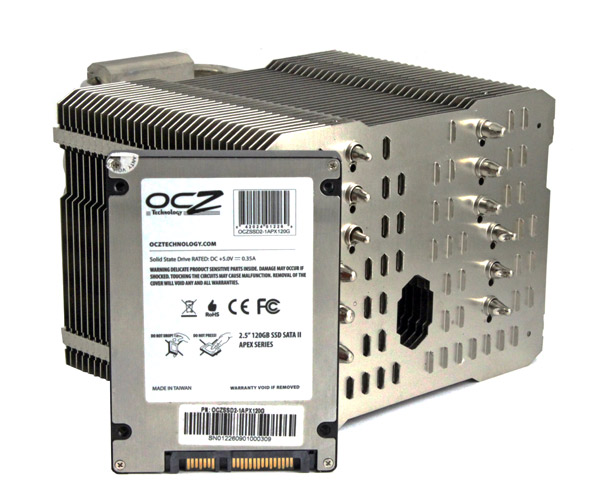
The bracket system with pressure adding mechanism (40~70lbs) is an interesting feature, but it didn't help us much in practice. The pressure system was made to make HR-02 cooler better fitted with different CPU surfaces. Generally speaking, you do not want to apply an excessive amount of pressure onto the processor as it might result in damaging it.
Our testing reveals that applying almost maximum pressure results in 1°C lower temperature on our Core i7 930 but tightening the screw we couldn’t shake the feeling that we’ll crush the CPU. Thermalright says that the ideal pressure would be half screw in, or just a little 1/4 in on the Core i7, whereas our advice would be to tighten it until you feel resistance. 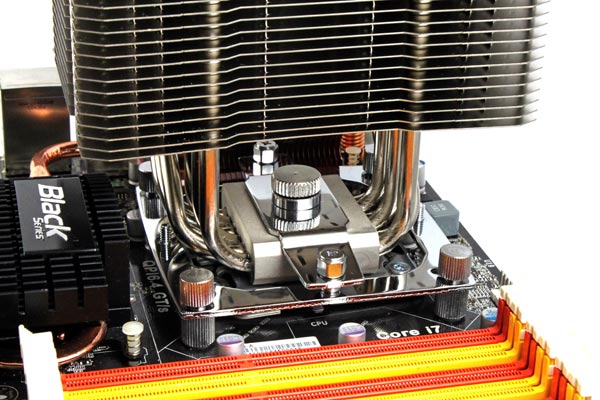
Thermalright currently has a mounting mechanism that works only with Intel sockets 775/1156/1366, which leaves AMD out of the picture. The company did, however, announce it’s working on an AMD socket mounting mechanism.
HR-02 doesn’t come with a provided fan but Thermalright included two brackets – one for a 12cm and one for a 14cm fan, so you can mount two fans. We ended up using the 12cm fan bracket when we were mounting a second 14cm fan, but naturally this is not advisable as the fan won’t be held properly. 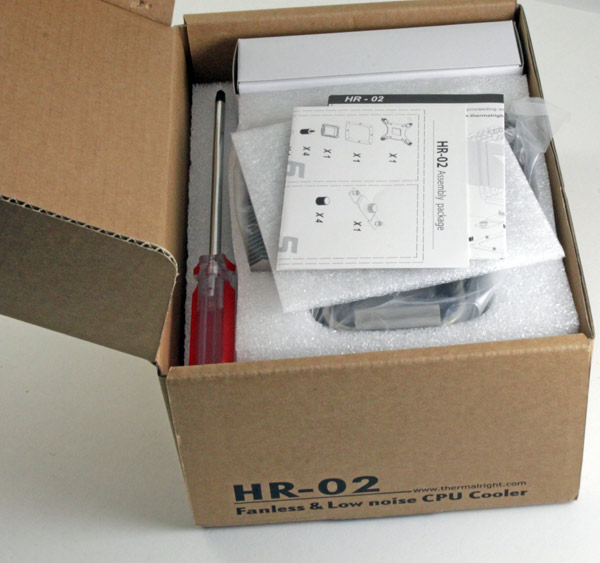
You’ll also find a long screwdriver, installation manual, Chill Factor3 thermal paste and anti-vibration elements with sticky tape for one fan. 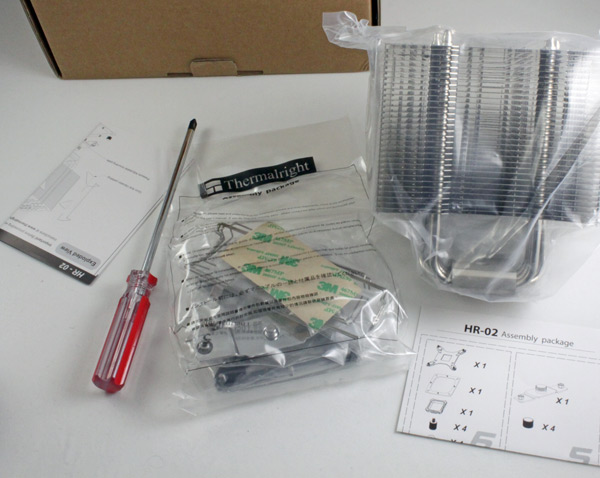
Setting the HR-02 up is pretty simple, and the mounting procedure is pretty much the same for all supported Intel sockets as the backplate and the rest of the parts are universal.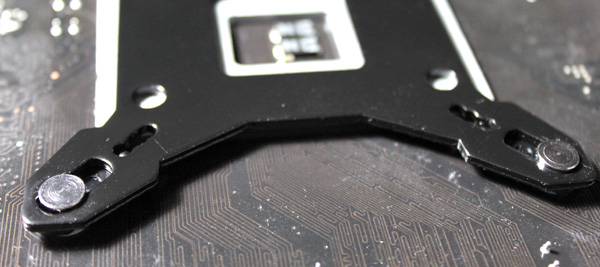
The motherboard on the picture is Elitegroup’s X58B-A. Mounting the HR-02 on it was a breeze and as Thermalright says, HR-02 is compatible with most motherboards.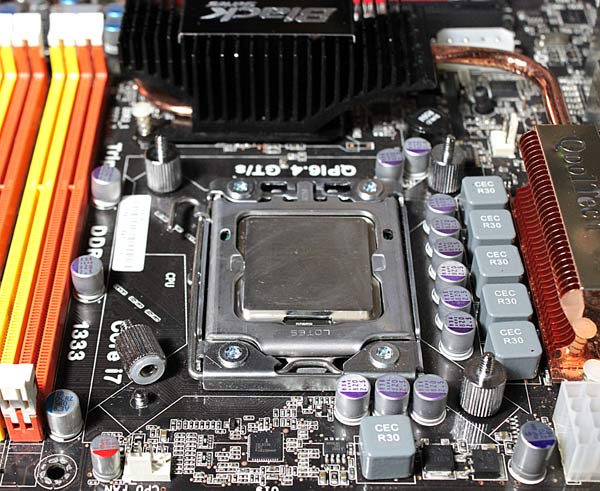
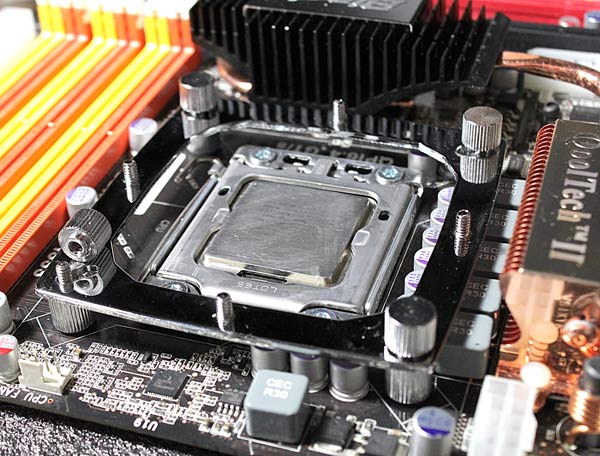
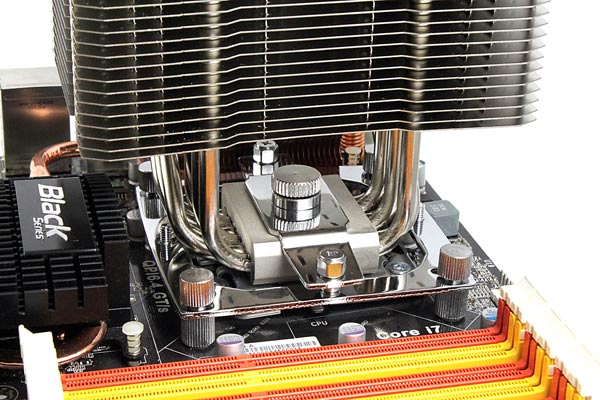
The following picture clearly shows that the cooler’s heatsink is nudged forwards, in order to boost efficiency by utilizing the rear panel fan.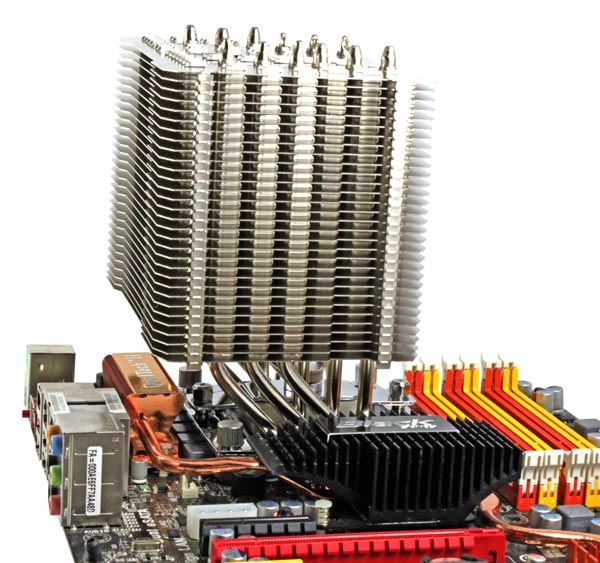
Thermalright HR-02’s motherboards compatibility list includes many motherboards currently on the market, and you can check out the list here. We’d however advise you to take the list with a grain of salt as we managed to mount the HR-02 on an EVGA X58 FTW3 with ease, despite the fact that the motherboard was listed as incompatible.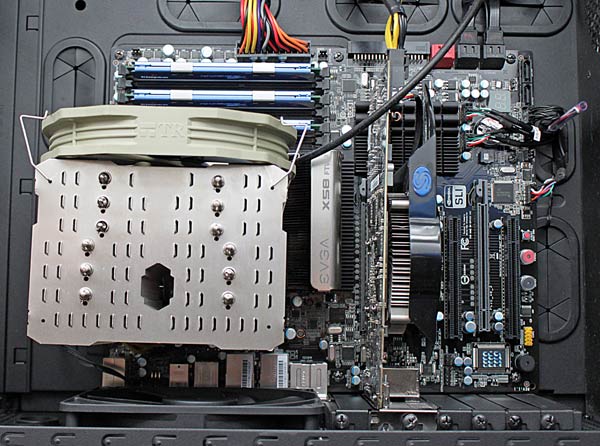
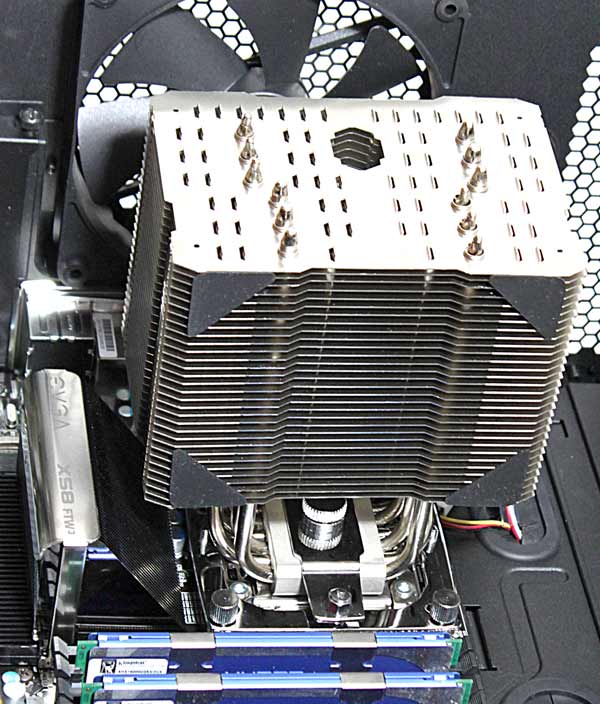
EVGA Classified 4-Way SLI motherboard is listed as compatible but we’d rather put it as partially-compatible. The reason for this is that the chipset’s large heatsink will make you turn the HR-02 towards the top panel fan.
EVGA Classified 4-Way SLI, on the other hand, is listed as compatible. Unfortunately, in our book it should be listed as semi-compatible or something of the sort as its large chipset heatsink got in the way of HR-02, so we had to turn the latter towards the top panel fan. Naturally, in this case you’ll have to rely on the top-panel one, if you have one of course. That didn’t bother our HR-02 too much placed inside HAF X case as it was still pretty efficient.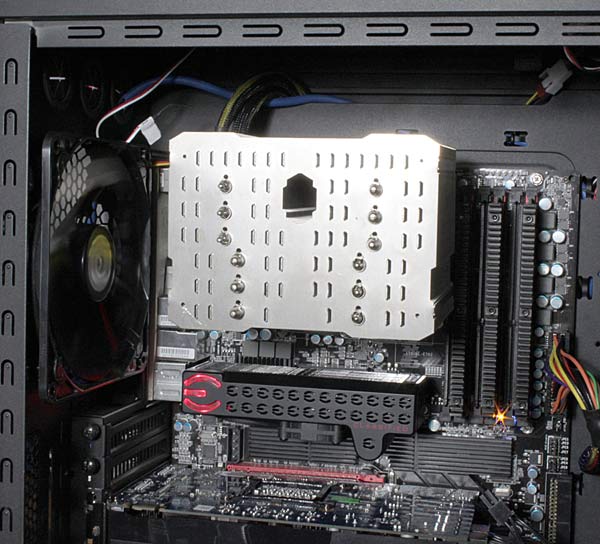
We’ve shown you initial results scored by the HR-02, but our testbed used an older system based on EVGA’s 780i SLI motherboard (socket 775), which also isn’t fully compatible with the HR-02. We easily fixed the problem by mounting a small passive heatsink with two smaller heatsink (pictures below).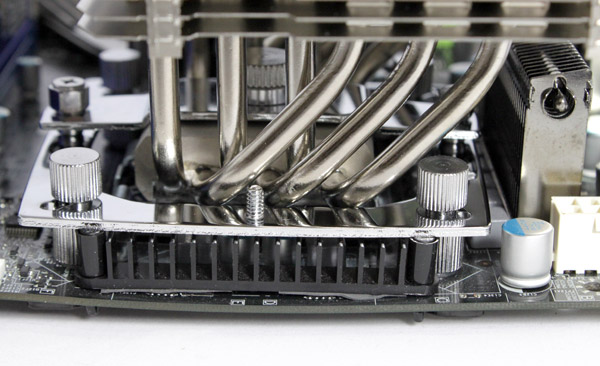
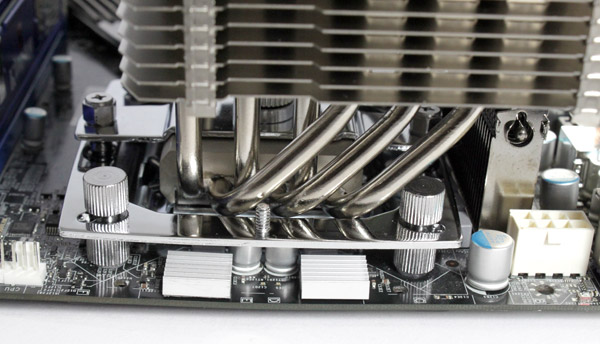
We tried the HR-02 on a few motherboards and in two different computer cases. Most of our testing was performed in Corsair Obsidian 800D case with the rest in CoolerMaster's HAF-X. Both cases were strapped with default fans at maximum RPM and our room temperature was at 22°C. We pushed all the available cores to 100% using Prime 95 (Small FFT) so bear in mind that these results are the worst case scenarios that are very unlikely to occur in practice. In our gaming tests, temperatures on both coolers were about 15°C lower.
We compared the HR-02 with Prolimatech’s Armageddon. Thermalright HR-02 hasn’t managed to beat Armageddon with high margin when we strapped both coolers with fans, but semi-passive mode worked out in HR-02’s favor. The following tests have been performed on EVGA’s X58 FTW3 motherboard in Obsidian 800D case, where Armageddon couldn’t stop our Core i7 930 from going over 100°C. We measured and recorded average temperatures from all the CPU cores.
We managed to score significantly lower temperatures on the CPU cores by strapping our coolers with Thermalright's TR-TY-140mm fan, as you can see for yourself from the table below.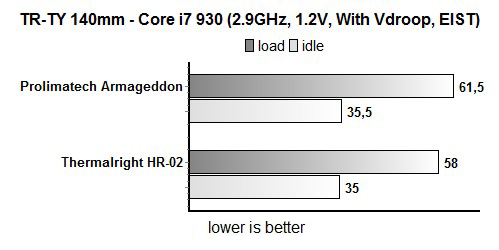
We then overclocked the CPU to 3.6GHz, leaving the fans on the coolers. Overclocking resulted in temperatures over 70°C and Armageddon kept pace with the HR-02, except of course in semi-passive mode.
In our previous tests, we kept the TR-TY 140mm (900-1300RPM) fan running at maximum RPM, but we performed the test with lower RPMs as well. We lowered the aforementioned fan’s RPM from 1300 to inaudible 900RPM, but it barely affected cooling performance. It’s worth noting that TR-TY 140mm fan is capable of 28.3-74CFM airflow.
We also received SilverStone’s SST-AP12 (12cm, 1500RPM) fan with 35.36CFM but while it has proven to be effective, we’d recommend a 140mm (preferably quiet) fan for the HR-02.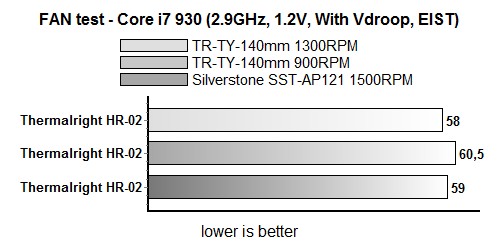
We used Gelid’s GC-Extreme thermal paste in our tests, but we couldn’t resist the urge to try the Chill Factor3 paste, which comes with the HR-02. The results are pretty good, almost as good with Gelid’s.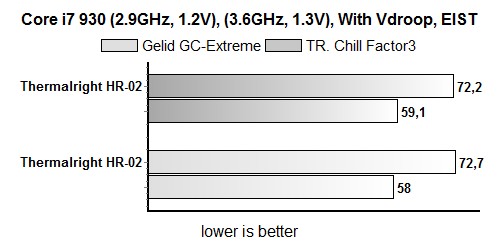
We performed additional HR-02 cooling performance tests in CoolerMaster’s HAF-X, which has more fans than Obsidian 800D. We used EVGA’s 4-Way SLI Classified motherboard, but since the large cooler on the mobo’s chipset got in the way of our cooler, we had to turn the HR-02 towards the case’s top panel fan. We tested it in semi-passive operation on Core i7 Extreme 965, and it’s evident that the top panel fan will dictate much of the HR-02’s performance. In fact, temperatures jumped by more than 20°C when we turned it off.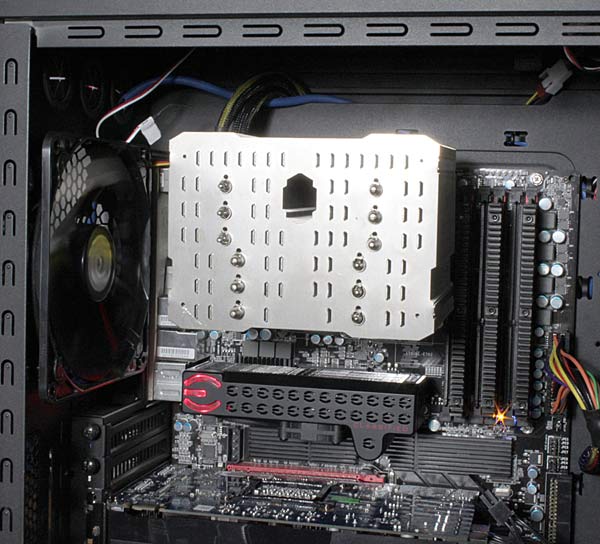
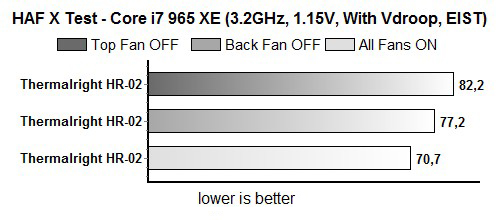
We also thought it would be interesting to see how Thermalright’s HR-02 performs with older CPUs. We used Intel’s socket 775 motherboard with Core 2 Extreme X6800 processor clocked at 2.9GHz (TDP 75W) and a passively cooled Gigabyte 9800GT. The test system was in CoolerMaster’s HAF X case with 4 fans. Room temperature was at 23-24°C. In order to push our CPU and graphics to the max we used Prime 95 like in the tests before. This time however, we added a bit of graphics torture with FurMark. The in-case fans ran at max RPM but HAF X didn’t mind and didn’t even run that loud. Compared to the two-year old and much cheaper passive Hyper Z600 cooler, Thermalright HR-02 was much more efficient.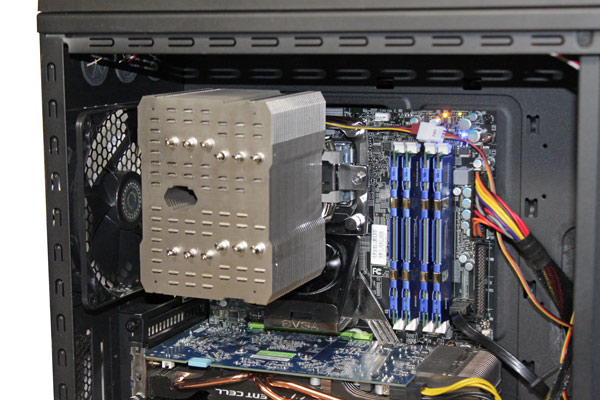
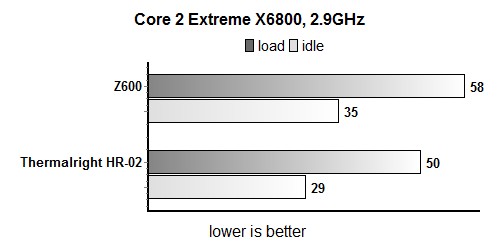
Thermalright HR-02 cooler is aimed at high-end users and enthusiasts looking for top cooling performance. If you’re looking for an inaudible cooling solution then HR-02’s semi-passive mode will definitely strike your chord. In fact, by utilizing in-case high airflow, HR-02 will have no trouble cooling the Core i7 965 Extreme. HR-02 is currently priced at about €60, here. This is €10 more than what Prolimatech’s Armageddon goes for here, but these €10 more will provide your with a seriously silent semi-passive cooling of your CPU.
However, Thermalright’s HR-02 is definitely a large cooler and you might want to check for compatibility with your motherboard prior to purchase. If it is indeed compatible, then we have no choice but to recommend it to you as it’s the only CPU cooler that allowed for semi-passive cooling of Core i7 CPUs. Furthermore, it performed like a champ in overclocking when we strapped it with a 140mm fan, which means you’re covered in pretty much any scenario.